Nihari is a hearty beef stew with large chunks of tender fall-apart beef shanks in a silky and mouth watering gravy. This authentic recipe from the Indian subcontinent is so easy and includes slow cooker instructions and tips to lighten it up.
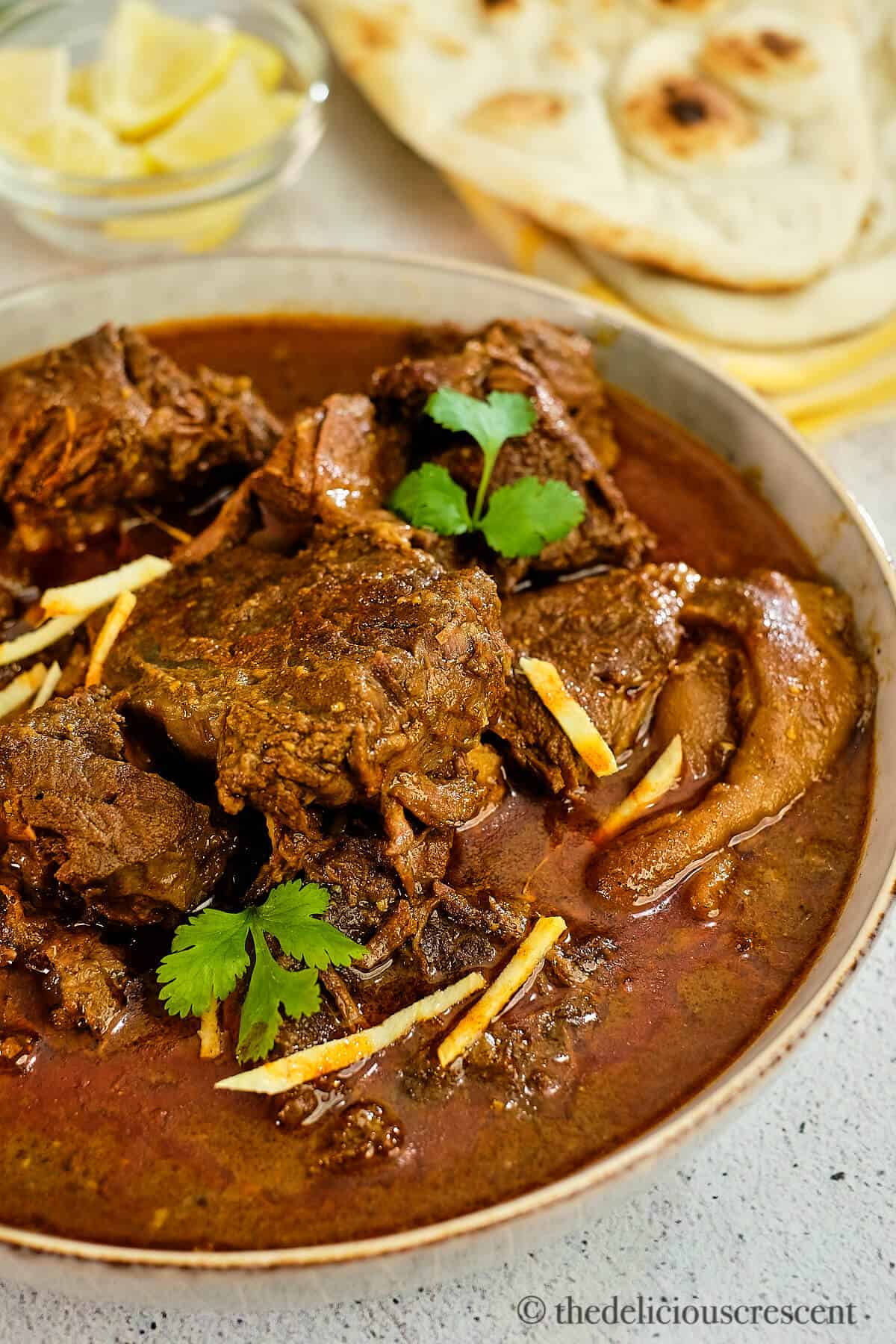
Braised Beef Shank Stew (Nihari)
Nihari is a popular stew from the Indian subcontinent, that is made with shank meat and bones. This delicacy with its roots in the Mughlai cuisine of Old Delhi and Awadh, is especially common in North India, Pakistan and parts of India with a larger Muslim population.
Traditionally, braised shanks were slow-cooked overnight with bones, onions and spices, turning it into a breakfast feast by morning. The meat is meltingly soft, falling apart into the rich and silky gravy. It is then devoured with fresh baked naan, khameeri roti or phulka.
Nalli nihari is a delicacy that is cooked with bones, and the marrow is scooped out and added back to the stew, making it richer. Although enjoyed year round, nihari can be a real treat in winter time. You can say that this braised beef shanks stew recipe is the Osso Buco of the orient!
Large chunks of fall-off-the bone tender beef shanks in a silky rich gravy is a sure keeper. One of the easiest delicacies ever!
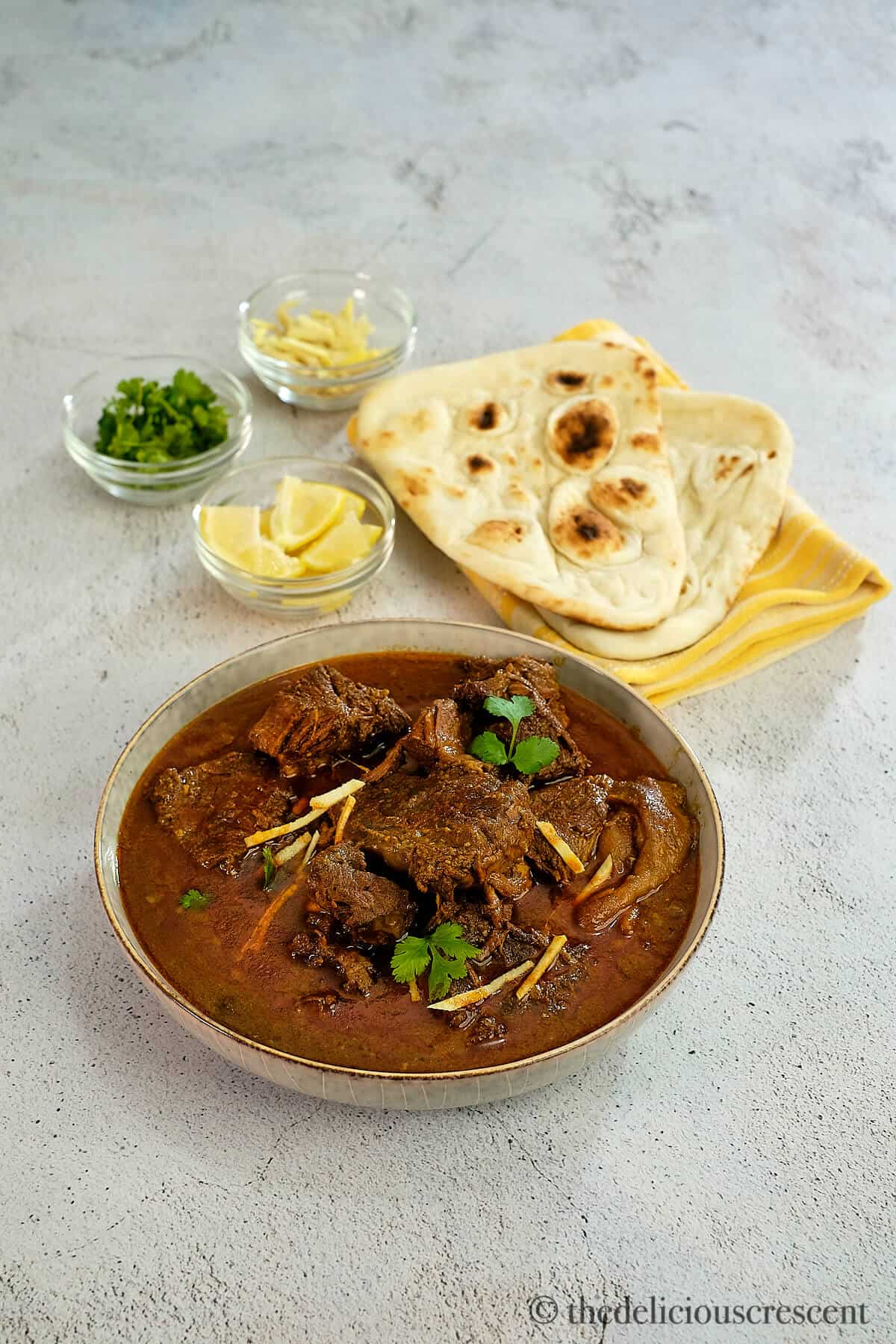
Ingredients for Nihari
Shank Meat, Bones, Onion, Oil, Spices, Ginger, Garlic, Durum Whole Wheat Flour (Atta), Green Chilies, Cilantro
What Meat to Use?
- Shank Meat: Traditional nihari recipes use lamb or beef shanks. In north America, beef is the popular choice for this recipe. But you can also use lamb, goat or chicken leg quarters and adjust cooking times.
- Nihari Meat Cut: The beef shank meat is cut in large 3 inch pieces. Butchers from the Indian subcontinent and halal meat shops are familiar with this meat cut. If not, try finding shank cross-cuts used for making the Italian Ossobuco.
- Alternative Meat Cuts: Any meat cut with lots of connective tissue and some fat, that are suitable for braising - beef short ribs, beef chuck roast, oxtail, lamb shoulder, lamb neck and such. Other cuts of meat will not give you the same result.
- Bones: Try to use marrow bones. Ask your butcher for some extra bones when you shop for meat shanks. It will give you the perfect Nihari taste. If not, try to use some bone broth as the cooking liquid. Adjust the amount of bones used, if the meat cuts already have some bone in it.
Do verify that it is shank meat, cut in large pieces, to get that famous texture and taste.
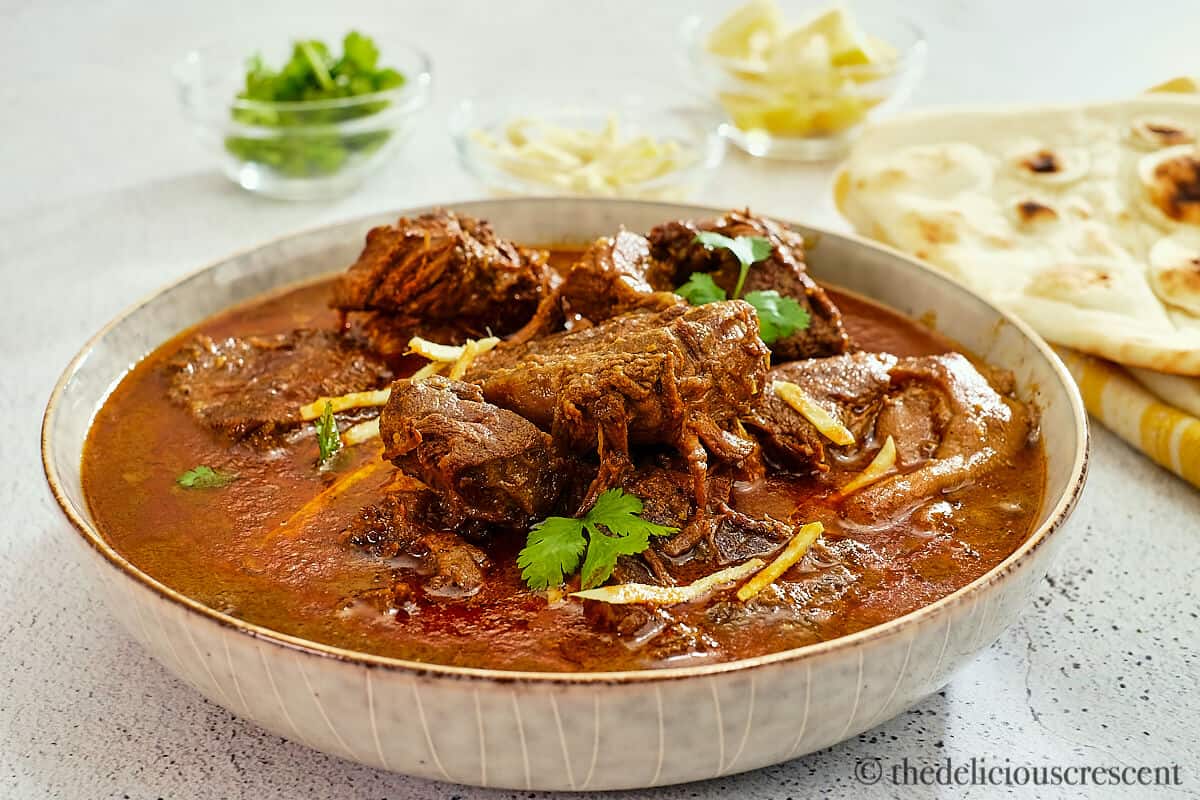
Nihari Masala
- Homemade Spice blend: The spices for nihari masala are listed in the recipe card below. Prepare it in bulk for multiple uses.
- Ready Made Spice Mix: Typically I don't use store bought blends, but this stew is an exception, where a small amount of the popular Shaan nihari mix can add an interesting taste sometimes. Use only a tiny bit with the homemade spice blend, as it is very hot and salty.
Flour for Thickening
- Durum Whole Wheat Flour: For authentic taste, use the Indian whole wheat flour, also known as “atta”, for thickening the stew. Alternatively, some people dry roast all purpose flour at low heat for about 5 minutes until it is aromatic and light tan in color.
- Gluten-free: Use rice flour, chickpea flour or a combination of these flours with corn starch (3 parts rice or chickpea flour + 1 part corn starch). Dry roast the rice or chickpea flour as above.
How to Make Nihari
**Below is a brief overview. Full nihari recipe is at the end of post.
Step 1: Roast and grind spices. Sauté sliced onions until golden brown. Sear meat shanks at high heat.
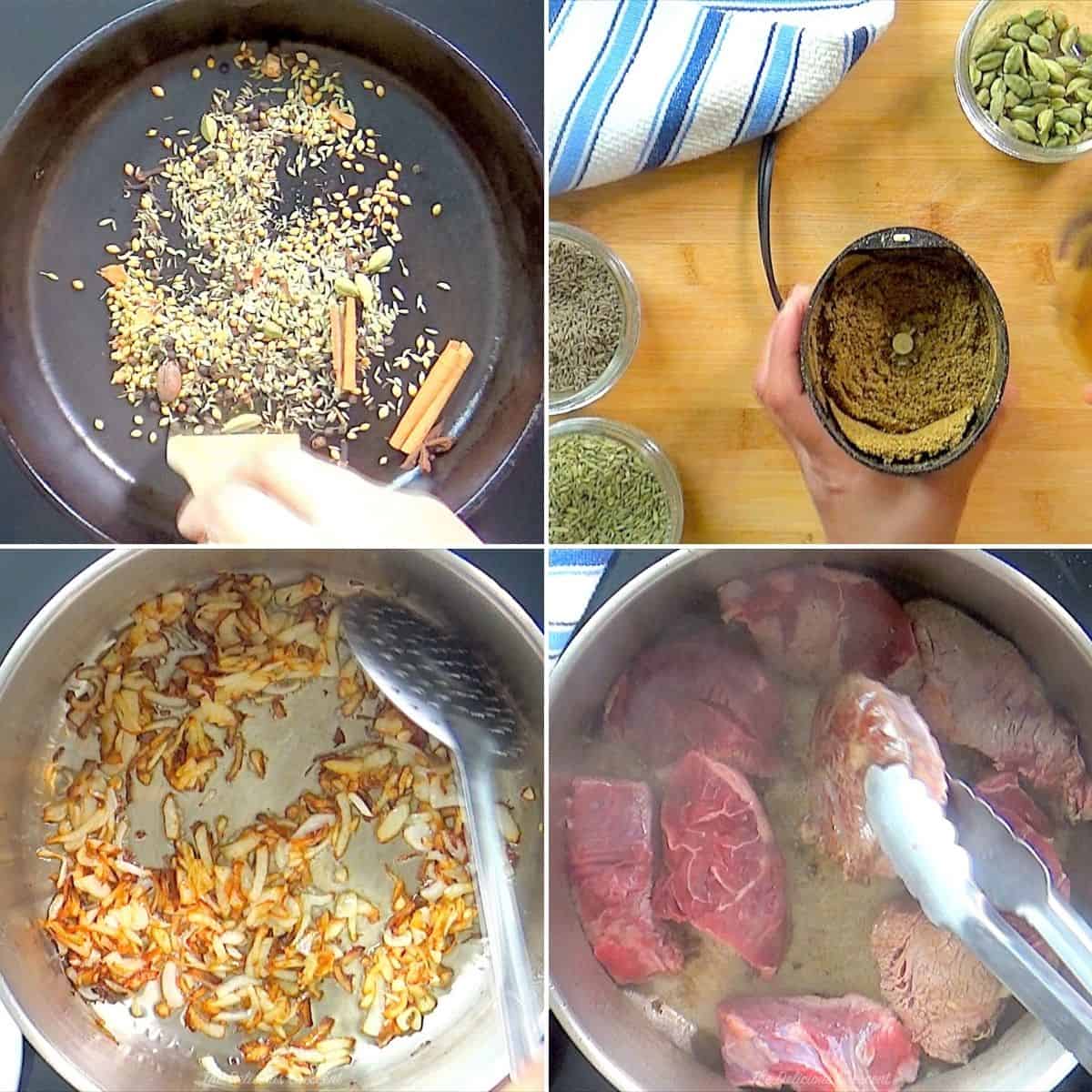
Step 2: Stir in ginger, garlic, spices, bay leaves and fried onions. Pour water.
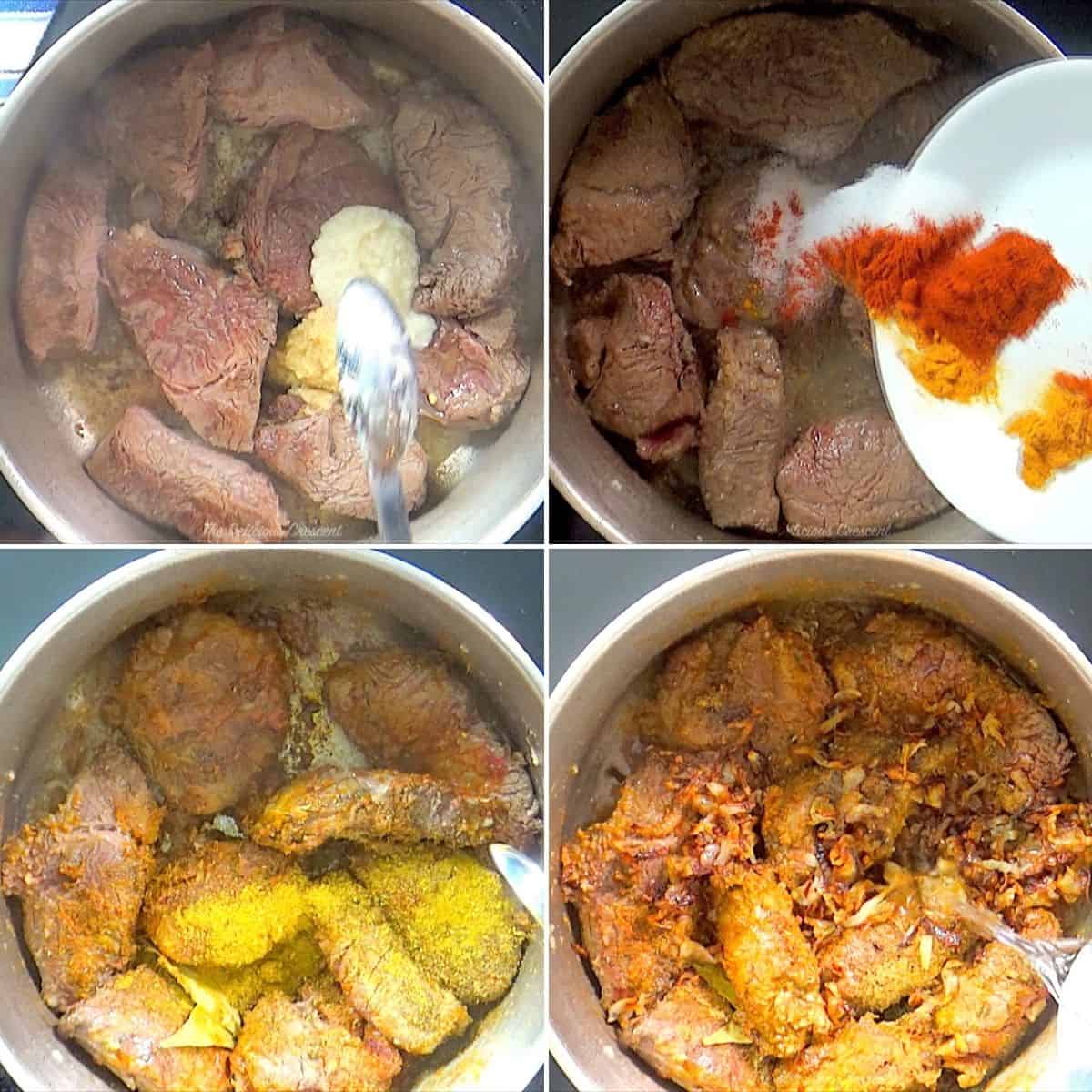
Step 3: Add bones and bring it to a boil. Lower the heat and simmer until meat is almost done. Make a thin flour paste and add it gradually while stirring stew. Simmer nihari until meat is fall-apart tender and oil trickles to the top.
As the meat cooks slowly for a long time, the collagen in the connective tissue breaks down, dissolving into the gravy giving it that thick, smooth and silky consistency.
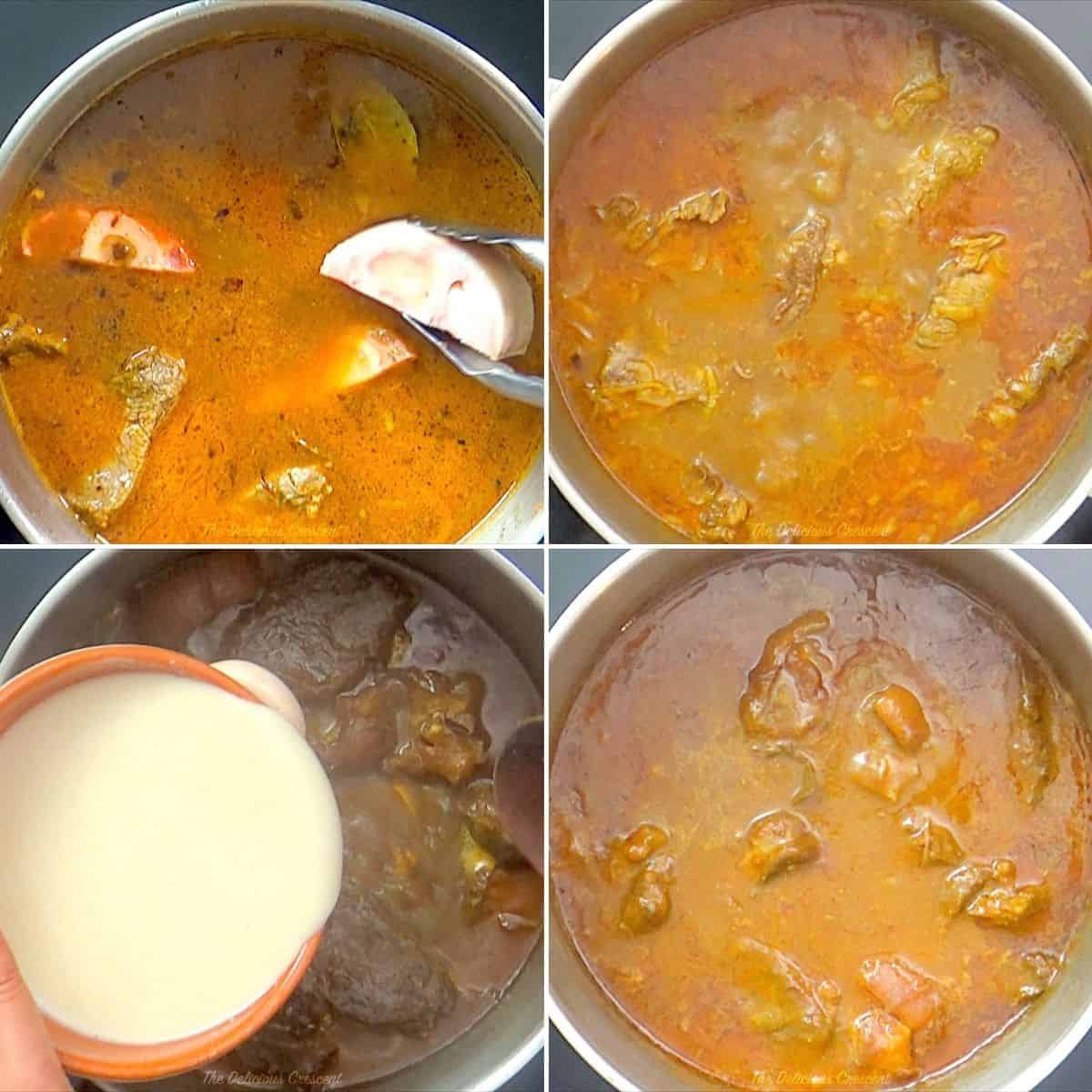
Step 4: Discard bones and bay leaves. Serve hot, topped with ginger and cilantro. Sliced green chilies and lemon wedges on the side.
Nihari is one of the best recipes to make in a slow cooker. It will turn out perfect. Collagen break down needs times, which slow cooking allows. Slow cooker instructions in recipe card notes below.
Top Tips
- Don't let the long list of spices deter you. That is the only big effort in this recipe.
- Brown the meat, onions, ginger garlic paste very well. Don’t skimp on the spices and other aromatics.
- Do not add the flour directly to the cooking pot. Be sure to use flour only as needed. If you use too much flour paste the gravy will become too thick.
- Use sufficient oil to cook the recipe. Spoon off the excess from the surface.
- Do not use too much of the branded spice mix. It is very spicy and salty. You can make terrific Nihari using only the homemade spice blend too.
- Large meat cuts result in longer strands, when the meat cooks until fall-apart tender.
- Some Indian nihari recipes use yogurt while browning meat with spices.
Tari (Oil Layer)
- As the beef nihari simmers, much of the oil will gradually trickle to the surface. Drizzling a few drops of oil can help initiate the trickling of oil.
- If the stew is too thick, the oil will not trickle up easily.
- Spoon off the excess oil and use it later to drizzle on the nihari as needed.
- Or make a seasoned oil with paprika or chili powder as mentioned in the recipe card notes.
Can I use Garam Masala?
No, garam masala will not work for this nihari recipe. You will need the special spice blend to get that ultimate taste.
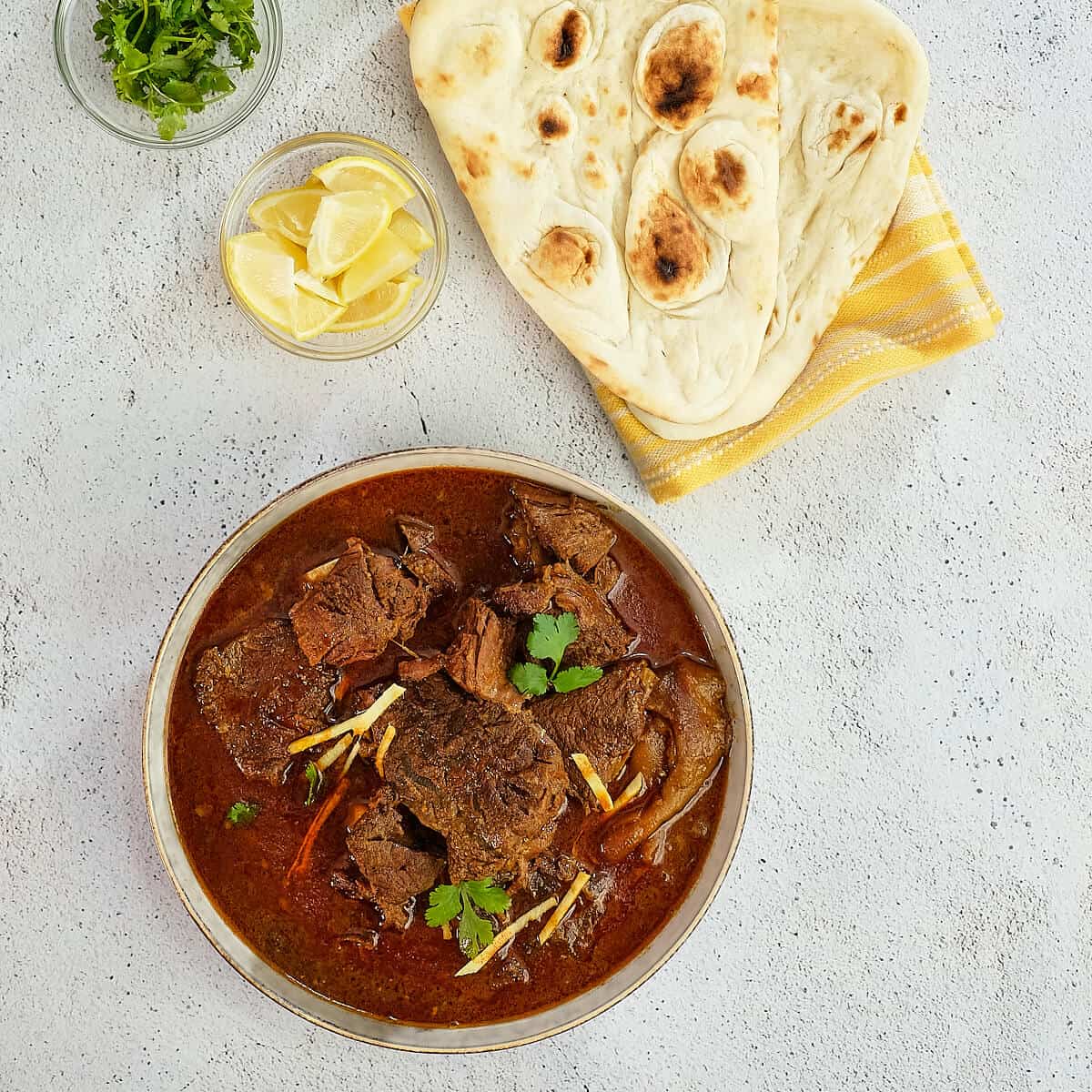
How to Serve Nihari?
Beef nihari is fantastic with fresh baked naan, khameeri roti or phulka, to soak up the gravy. Try it with hearty whole wheat naan or easy skillet flatbreads. Add some fresh salads or side dishes - salad shirazi, aloo gobi.
Plating nihari properly is important. Arrange the large chunks of meat in a wide serving dish and then pour some gravy around it. Make sure that the meat chunks are visible. Drizzle stew oil on top.
Garnish with fresh julienned ginger and cilantro. Serve sliced green chilies and lemon wedges on the side, to be used as per taste. You can top with some fried onions too.
How To Store
Leftovers can be stored for 4 to 5 days in the refrigerator. This stew is very freezer friendly. Make a lot of it, portion it in Tupperware and freeze it for later. Thaw and reheat on stove top. Add some water to adjust consistency while reheating.
Nihari tastes even better the next day!
This stew does use quiet a bit of oil for its preparation. But much of the oil will surface on the top of the cooked gravy. Spoon off the oil and enjoy the beef stew. It is still going to be very tasty. You don’t need layers of oil on the top for a great Nihari.
Nutrition Facts
This is an egg free, soy free, dairy free and nut free stew. Make it gluten free by replacing durum wheat flour with rice flour, chickpea flour or a combination of these as suggested under “Ingredients” above.
Beef is an excellent source of high quality protein, some B vitamins (Niacin, B12, B6), zinc, phosphorus, selenium, and is also a good source of iron.
I would recommend choosing grass fed beef as it is a better source of CLA (conjugated linoleic acid) and omega-3 fats. And also for many other healthy benefits.
However, include red meat only in moderate amounts in your diet. And you may opt for chicken for an equally delectable Nihari.
More Meat Recipes
Full Recipe Video
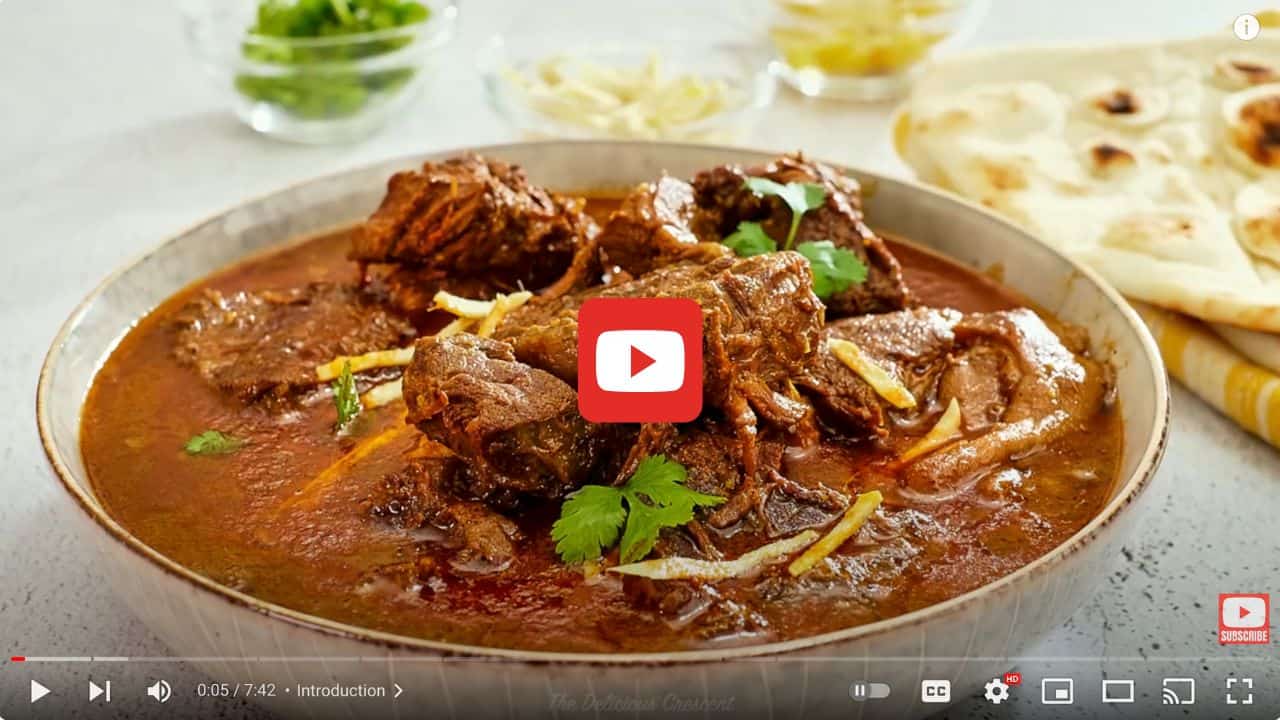
★ DID YOU MAKE THIS RECIPE? PLEASE COMMENT AND GIVE IT A STAR RATING BELOW!
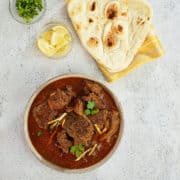
Nihari (Beef Shank Stew)
Ingredients
Spice Mix (Nihari Masala)
- 1 tablespoon coriander seeds
- 1 tablespoon fennel seeds
- 1 teaspoon black peppercorns
- 1 teaspoon cumin seeds
- 1 teaspoon shah jeera black cumin seeds, see note
- 1 teaspoon ground ginger
- 1 cinnamon stick 3 inches
- 6 green cardamom
- ½ teaspoon cloves
- 1 black cardamom
- 1 blade mace
- 1 star anise small
- ¼ teaspoon nutmeg
- 1 teaspoon black seeds optional
Nihari Beef Stew
- ⅓ cup olive oil see note
- 1 onion large, thinly sliced
- 2 pounds beef shanks cut in 3 inch pieces, Nihari style cut, see note
- 1 pound bones marrow bones preferably
- 1 tablespoon grated ginger
- 1 tablespoon grated garlic
- 1 tablespoon paprika use Kashmiri chili powder for more hot
- 1½ teaspoons chili powder use Kashmiri red chili powder for milder
- ½ teaspoon turmeric
- 1½ teaspoons salt adjust per taste
- 4 tablespoons Nihari spice blend from above
- ½ tablespoon Shaan Nihari spice blend optional, reduce chili powder and salt if using this
- 2 bay leaves
- 8 cups water or bone broth
- ⅓ cup Atta Durum whole wheat flour, increase to ½ cup for thicker stew
Garnish
- 2 tablespoons julienned ginger
- 2 tablespoons cilantro
- 1 lemon cut into wedges
- 1 green chili pepper sliced (Jalapeño - milk, Serrano - Hot)
- Fried Onions
Equipment
- Cast Iron Skillet
- Spice Grinder
- Large Cooking Pot
- Mandolin Slicer
- Cutting Board
- Small Bowls
Instructions
- Roast whole spices in a preheated cast iron skillet until fragrant. Allow the spices to cool and grind into fine powder.
- Heat oil in a large cooking pot at medium high. Add sliced onions, sauté until golden brown and set it aside.
- Rinse the shank meat pieces and pat dry using paper towels. Then rinse the bones and set it aside.
- In the same oil, sear the meat shanks at high heat and on all sides. Add ginger, garlic and stir couple minutes until the raw flavor disappears.
- Next add paprika, chili powder, turmeric, salt, nihari spice blends, bay leaves and stir. Add the fried onions back to the pot. Pour 6 cups of water, add bones and bring it to a boil. Lower the heat and let it simmer for 2 to 3 hours. Add more water as needed.
- When the meat is about 80 percent done, take 1 cup of the cooking liquid into a small bowl and let it cool. In another small bowl take whole wheat flour (atta), whisk in the cooled cooking liquid gradually to make a smooth and thin paste.
- Add the paste back to the stew slowly while stirring it quickly to prevent lump formation. (Tip: Like making a thin custard or thickening a soup)
- Let the nihari simmer for about 45 minutes until the meat is fall-apart tender (breaks easily with a wooden spoon) and the oil gradually trickles to the surface. The gravy should be thick but of pouring consistency. Discard the bones and bay leaves.
- Add a bit more flour or liquid to adjust the consistency as needed. Nihari will thicken as it will cool, so turn off the heat when it reaches about 80 percent of desired thickness. Spoon off excess oil from the top and save it for later.
- Serve the beef stew hot, topped with julienned ginger, chopped cilantro and a drizzle of stew oil saved earlier. On the side, serve sliced green chilies and lemon wedges to use as per preference. Enjoy nihari with naan.
Notes
- Meat: Beef, lamb and goat shanks are ideal or use cuts with lots of connective tissue. For chicken, use leg quarters. Indian subcontinent/Halal meat stores are familiar with the Nihari meat cut. If not, try shank cross-cuts used for making the Italian Ossobuco.
- Bones: Adjust the amount of bones, if using bone-in meat cuts. Use bone broth, if bones aren’t available.
- Paprika & Chili Powder: I use paprika for its nice red color but low heat. Use Kashmiri red chili powder instead of that for the same color but more heat. Regular chili powder is more pungent than Kashmiri chili powder.
- Branded spice mixes may include salt and chili powder. If using it, be sure to adjust the salt and chili powder accordingly.
- Make Ahead: The spice blend can be made in bulk and stored up to 6 months.
- Storage: Refrigerate leftovers for 5 to 6 days. Freeze Nihari in small portions for couple months. If stew is too thick when reheating, then add some water to adjust consistency.
- Slow Cooker: Nihari is one of the best recipes to make in a slow cooker.
- Saute onions, sear meat, cook with ginger, garlic and spices in a cooking pot on the stove (up to step 5 in recipe card above). Then transfer it all to slow cooker.
- Add water, stir and slow cook - at low setting for 6 to 8 hours; at high setting for 5 to 6 hours, until meat is fall-apart tender.
- Then return to step 6 and complete. Adjust times as per the slow cooker and meat.
- Shajeera: These may be referred to as black cumin or black caraway seeds in Indian stores. The labeling is not consistent. Ask your Indian grocer for “shahjeera”.
- Seasoned Oil Drizzle: For a nice red color on top, heat some oil and turn off the stove. Then stir in paprika or Kashmiri chili powder. Drizzle this oil on top.
- For step by step pictures, ingredient notes and other tips, scroll up the page to the blog post.
Nutrition
More Indian Recipes
This post was first published on January 31, 2021 and has been updated with video, process photos, recipe formatting, tips, and additional enhancements.


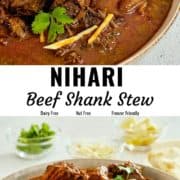
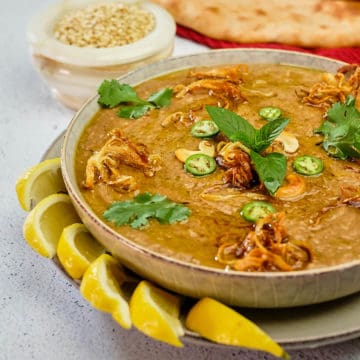

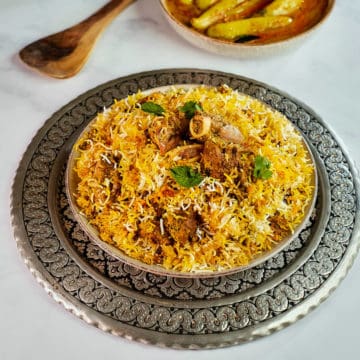
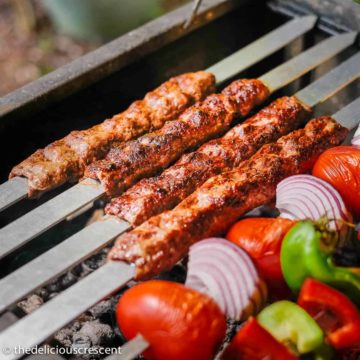
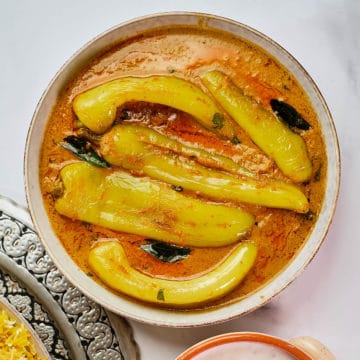
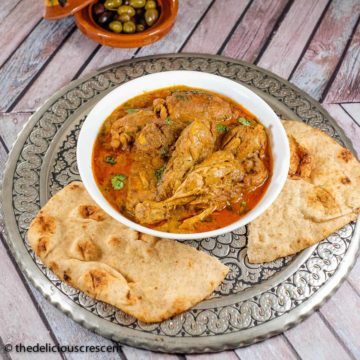
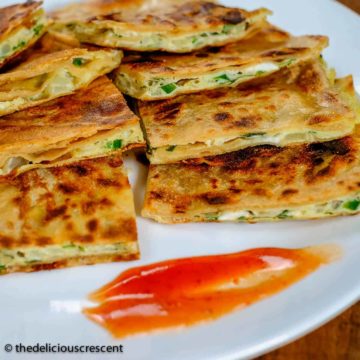
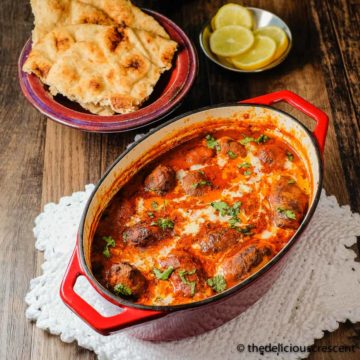
Theresa
I tried this recipe and it's really good.
Sara
Love soup season for recipes just like this one! Looking forward to warming up with this for dinner tonight; looks too good to pass up, indeed!
Cathleen
Okay, I guess I am going to go out and buy all of these spices because this looks too good NOT to make!!
Roxana Begum
You must. Guaranteed amazing. No wonder its so popular.
Donna
I grew up on Irish stew and have been making it for years, this was a alternative to try out, loved the flavors!
Maggie
Just the sight of this Nihari makes my tummy go loco! It looks really scrumptious! I can't wait to taste this.
Roxana Begum
Absolutely delicious. Worth a try!
Andrea
Wow, so many wonderful spices in this stew and the meat looks so tender and delicious.
Capri
This stew is so delicious and flavorful! Thank you for the recipe!